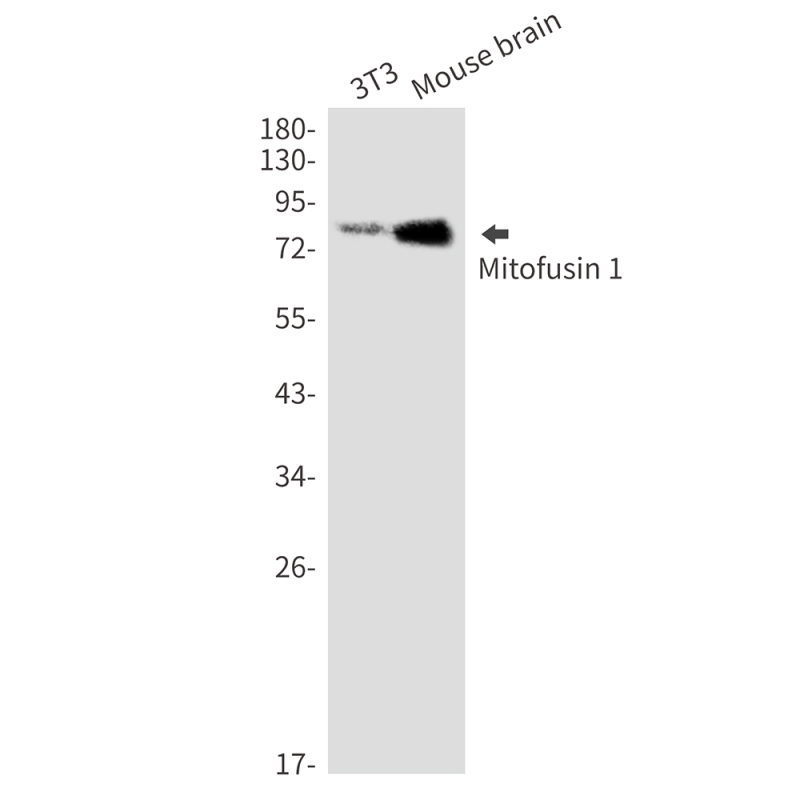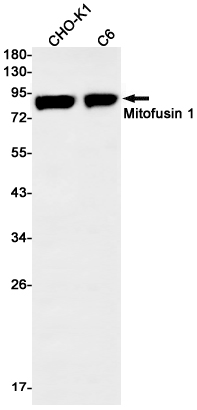

| WB | 1/500-1/1000 | Mouse,Rat,Hamster |
| IF | 1/20 | Mouse,Rat,Hamster |
| IHC | 咨询技术 | Mouse,Rat,Hamster |
| ICC | 技术咨询 | Mouse,Rat,Hamster |
| FCM | 咨询技术 | Mouse,Rat,Hamster |
| Elisa | 咨询技术 | Mouse,Rat,Hamster |
| Aliases | HR2; mKIAA4032; D3Ertd265e; 2310002F04Rik; 6330416C07Rik |
| Entrez GeneID | 192647 |
| WB Predicted band size | Calculated MW: 84 kDa; Observed MW: 84 kDa |
| Host/Isotype | Rabbit IgG |
| Antibody Type | Primary antibody |
| Storage | Store at 4°C short term. Aliquot and store at -20°C long term. Avoid freeze/thaw cycles. |
| Species Reactivity | Mouse,Rat,Hamster |
| Immunogen | A synthetic peptide of rat Mitofusin 1 |
| Formulation | Purified antibody in TBS with 0.05% sodium azide,0.05%BSA and 50% glycerol. |
+ +
以下是3篇涉及Mitofusin 1(MFN1)抗体的代表性文献概览:
1. **文献名称**:*Mitofusin 1 and 2 regulation of mitochondrial DNA content is a critical determinant of glucose homeostasis*
**作者**:Chen H, et al.
**摘要**:研究利用MFN1特异性抗体(Western blot)证明MFN1敲除小鼠模型中线粒体融合蛋白缺失,揭示MFN1通过调控线粒体DNA稳定性影响胰岛β细胞功能及糖代谢。
2. **文献名称**:*MFN1 structures reveal nucleotide-triggered dimerization critical for mitochondrial fusion*
**作者**:Qi Y, et al.
**摘要**:通过MFN1抗体(免疫荧光)定位线粒体形态,结合晶体结构分析,阐明MFN1依赖GTP水解的二聚化机制如何驱动线粒体外膜融合。
3. **文献名称**:*Dysregulation of mitochondrial fusion and fission in Alzheimer's disease*
**作者**:Wang X, et al.
**摘要**:采用MFN1抗体(免疫印迹及免疫组化)检测阿尔茨海默病模型中线粒体融合蛋白表达下降,提示MFN1功能受损导致神经元线粒体碎片化,加剧病理进程。
---
**注**:以上文献均使用MFN1抗体作为关键实验工具,涉及疾病机制、蛋白功能及结构研究。建议通过PubMed或Web of Science输入标题进一步获取全文信息。
Mitofusin 1 (MFN1) is a mitochondrial outer membrane protein that plays a critical role in regulating mitochondrial dynamics, particularly in mediating membrane fusion. As a member of the dynamin-related GTPase family, MFN1 facilitates the tethering and merging of adjacent mitochondria, maintaining mitochondrial network integrity, metabolic efficiency, and cellular homeostasis. It works in concert with MFN2. a homologous protein, though MFN1 is predominantly involved in mitochondrial fusion, while MFN2 has additional roles in endoplasmic reticulum-mitochondria interactions.
Antibodies targeting MFN1 are essential tools for studying mitochondrial morphology, function, and associated pathologies. They are widely used in techniques such as Western blotting, immunofluorescence, and immunohistochemistry to detect MFN1 expression levels, subcellular localization, and post-translational modifications. Research applications include investigations into neurodegenerative diseases (e.g., Alzheimer’s, Parkinson’s), metabolic disorders, and cancers, where mitochondrial dysfunction is implicated.
MFN1 antibodies must be validated for specificity, as cross-reactivity with MFN2 or other proteins can occur. Epitope regions, such as the GTPase domain or coiled-coil structures, are common targets. Commercial antibodies are often raised against synthetic peptides corresponding to conserved human MFN1 sequences. Proper controls, including MFN1-knockout cell lines, are recommended to confirm antibody reliability. Dysregulation of MFN1 is linked to Charcot-Marie-Tooth disease type 2A and other mitofusinopathies, underscoring its clinical relevance. Understanding MFN1's role through antibody-based research continues to advance insights into mitochondrial biology and therapeutic strategies.
(Word count: 247)
×